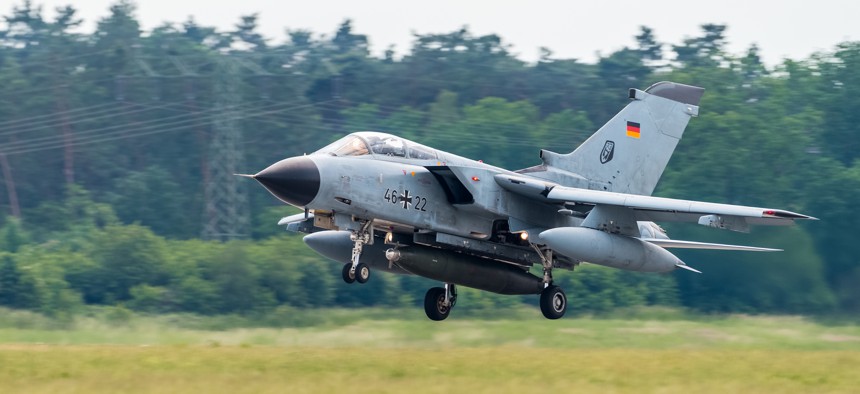
A 2016 photo of a German Air Force Tornado, one of the few aircraft that can drop U.S. B61 nuclear bombs. Julian Herzog
The US Should Remove Its Nukes from Europe
There’s no prudent use case, and their non-stealthy fighter jets can’t deliver them anyway.
Twenty-nine years ago this month, as the Cold War was ending, President George H.W. Bush took an extraordinary step. With the exception of a contingent of air-delivered bombs in Europe, he unilaterally withdrew from the field all U.S. tactical nuclear weapons. Although he had strong reason to believe that Soviet leader Mikhail Gorbachev might reciprocate, Bush had no assurances. In the end, the Soviet Union (and then Russia) did begin to draw down their own massive tactical nuclear holdings.
Today, that prudent move serves as an example. The United States still maintains some 150 B61 nuclear bombs in Europe and has also deployed a low-yield warhead, the W76-2, on submarines, marking the first time in three decades that U.S. tactical nuclear weapons are again at sea. Washington should reconsider this posture.
The United States and the Soviet Union were two scorpions in a bottle, as Robert Oppenheimer once described them – each capable of killing the other, but only at the cost of its own life. The fall of the Berlin Wall and the revolutions that ensued in Eastern Europe changed all of that. Bush had the wisdom to not only recognize this, but to understand and act on the implications for the nation’s tactical nuclear arsenal.
Yet the differences between the United States and Russia do not rise to the level of those presented by the Soviet Union. Russian policies can be both reckless and odious – from the illegal seizure of Crimea to the poisoning of Alexei Navalny – but they don’t present a global challenge to the United States or a basic threat to its way of life. Russia is a regional threat – with a number of weaknesses – that can best be met and contained through conventional means. Resort to tactical nuclear weapons therefore makes no sense – even in the event of a direct military clash with Russian forces, as, for example, could theoretically occur in the Baltic region.
The United States should therefore remove its remaining B61s and the alliance as a whole should rethink the role of tactical nuclear forces in its defense planning. Moreover, in foregoing the B61s, NATO would lose practically nothing in terms of warfighting capability. The bombs are dated anachronisms that face severe operational limitations and are also subject to a convoluted release process that would likely delay their timely employment in the event of a military crisis.
In the particular case of a possible Baltic war, the B61s would face two specific impediments to their effective use. First, the only NATO aircraft currently certified to deliver the B61 are the non-stealthy F-16 and Tornado. Neither plane stands a reasonable chance of making it through the teeth of Russia’s advanced air defense network in northeast Europe to reach its target. Even though it is nuclear, the B61 is still a basic free-fall bomb. Its delivery aircraft must fly over the target to drop the weapon, no different than a World War II bomber.
Second, there are almost no viable targets for a tactical nuclear weapon in a Baltic war. Use on the territory of Estonia, Latvia, or Lithuania would essentially involve killing citizens of those countries to “save” them. None of the three are large states and even tactical nuclear employment would carry significant humanitarian and environmental consequences. Use directly against Russia also must be ruled out as it could immediately invite a strategic exchange – the worst possible outcome. Targeting Russian units that might be transiting Belarus could be another option, but it is unclear whether this would affect the Russian advance and would also entail civilian casualties among a population that isn’t even willingly participating in the war.
In short, there is no reliable means to deliver the B61 in a Baltic contingency and practically nowhere to usefully employ them. So why keep them at all? Withdrawing the B61s unilaterally would entail far less risk than President Bush bore in 1991 as it doesn’t alter NATO’s defensive capability because the weapons are already functionally useless.
It is worth noting that such a step would not be a panacea for relations between the alliance and Russia. There is no guarantee Moscow would reciprocate with its own reductions – in fact the odds are it won’t. But it could be a useful first step in establishing a new dialogue with Russia on strategic stability in Europe – similar to the discussions that were routinely held at various points during the Cold War, such as the Mutual and Balanced Force Reduction talks and the negotiations that led to the Conventional Forces in Europe Treaty.
The action of triggering a similar dialogue with Russia now – on reducing nuclear and other risks, including the increasing number of close calls in the air – won’t immediately yield results. But it could lay the foundation for a de-escalation of tensions between the two sides in time.
The Cold War is long over. While Russia is a problematic, capable state, it is no longer an existential threat like the Soviet Union. Promulgating nuclear policies from the past that were designed to address a different order of threat therefore makes no sense.
Bringing the B61s home would be a first step in openly acknowledging that. It’s long past time that Oppenheimer’s “two scorpions” analogy ceased to apply.
Mike Sweeney is a fellow at Defense Priorities and the author of Reconsidering U.S. Nuclear Weapons in Europe.




